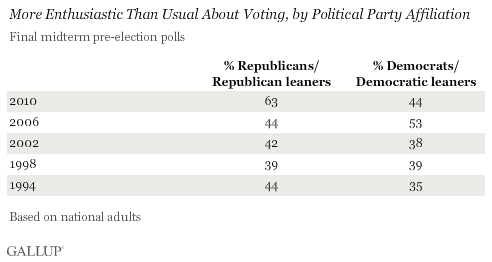PRINCETON, NJ -- Americans' enthusiasm about voting exceeds the recent midterm election high set four years ago, with 50% of Americans and 53% of registered voters saying they are more enthusiastic than usual about voting in 2010.

These results are based on the USA Today/Gallup final 2010 pre-election poll, conducted Oct. 28-31.
The record level of overall enthusiasm is primarily the result of Republicans' heightened excitement -- 63% of Republicans (including Republican-leaning independents) say they are more enthusiastic than usual about voting. That not only greatly exceeds Democrats' expressed enthusiasm this year, but also is substantially higher than what Gallup has measured for either party's supporters on the eve of a midterm election.

The high level of Republican enthusiasm has led to the largest gap in enthusiasm by party of any recent midterm elections, 19 percentage points. The prior highs were nine points in favor of the Democrats in 2006, and nine points in favor of the Republicans in 1994.
The party with the advantage in enthusiasm has won the greater share of the national congressional vote, and gained seats in the House, each election year since Gallup began tracking voter enthusiasm in 1994.
The well-documented enthusiasm gap, reflected in pre-election polls consistently showing Republicans doing well in 2010 election voting preferences, may explain why more Americans think a shakeup in Washington is more likely than not on Election Day. A recent Gallup poll found 49% of Americans saying there is a better chance this election will bring about major changes in Washington, while 44% disagree.
Gallup asked the same question prior to the 1994 elections -- which saw the greatest net shift of U.S. House seats by party in the last 50 years -- and Americans' expectations for change were lower in 1994 than they are today. That year, 40% of Americans thought there was a better chance of major change after those elections and 53% did not. Gallup has not asked this question in other midterm election years.
As one might expect with their party likely to gain seats in Congress on Election Day, Republicans (64%) are much more likely than Democrats (38%) to think the 2010 elections will bring about major change in Washington.
Gallup has documented that national political conditions are ripe for significant change in Congress, given low presidential approval ratings, low congressional approval ratings, and low levels of satisfaction with the way things are going in the United States, at a time when the same party holds the presidency and controls both houses of Congress.
Bottom Line
The 2010 elections could be historic from the standpoint of producing unusually large Republican gains in Congress. But the elections are already historic for a midterm election in the levels of enthusiasm Americans, and particularly, Republicans, have for voting this year.
Learn more about Gallup's likely voter models for the 2010 midterm congressional elections.
Survey Methods
Results for this USA Today/Gallup poll are based on telephone interviews conducted Oct. 28-31, 2010, with a random sample of 2,240 adults, aged 18 and older, living in the continental U.S., selected using random-digit-dial sampling.
For results based on the total sample of national adults, one can say with 95% confidence that the maximum margin of sampling error is ±2 percentage points.
Results for the question about chances for major change in Washington are based on telephone interviews conducted Oct. 21-24, 2010, with a random sample of 1,021 adults, aged 18 and older, living in the continental U.S., selected using random digit dialing.
For results based on the total sample of national adults, one can say with 95% confidence that the maximum margin of sampling error is ±4 percentage points.
Interviews are conducted with respondents on landline telephones (for respondents with a landline telephone) and cellular phones (for respondents who are cell phone only). Each sample includes a minimum quota of 150 cell-phone-only respondents and 850 landline respondents per 1,000 national adults, with additional minimum quotas among landline respondents for gender within region. Landline respondents are chosen at random within each household on the basis of which member had the most recent birthday.
Samples are weighted by gender, age, race, education, region, and phone lines. Demographic weighting targets are based on the March 2009 Current Population Survey figures for the aged 18 and older non-institutionalized population living in continental U.S. telephone households. All reported margins of sampling error include the computed design effects for weighting and sample design.
In addition to sampling error, question wording and practical difficulties in conducting surveys can introduce error or bias into the findings of public opinion polls.
View methodology, full question results, and trend data.
For more details on Gallup's polling methodology, visit www.gallup.com.
